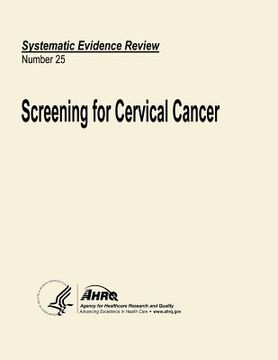Synopsis "Screening for Cervical Cancer: Systematic Evidence Review Number 25 (in English)"
Since introduction of cytologic screening for cervical cancer using the Papanicolaou (Pap) test in the 1950s, the incidence of invasive cervical cancer in the United States has fallen more than 100%. No other cancer screening program has been more successful. This fall occurred despite an increase in risk factors for cervical cancer, such as younger age at initiation of sexual intercourse, more sexual partners in a lifetime, and greater prevalence of human papilloma virus (HPV) infection and cigarette smoking. Success in prevention reflects three factors: (1) progression from early cellular abnormalities, termed low-grade dysplasia, through more severe dysplasia, to carcinoma in situ and invasive cancer is generally slow, allowing time for detection; (2) associated cellular abnormalities can be identified; and (3) effective treatment is available for premalignant lesions. Consequently, invasive squamous cell carcinoma of the uterine cervix is a highly preventable disease. Introduction of screening programs in populations naïve to screening reduces cervical cancer rates by 60% to 90% within three years of implementation. This reduction of mortality and morbidity with introduction of screening with the Pap test is consistent and dramatic across populations. As a result, Pap testing is one of the few preventive interventions that has received an .A. recommendation from the US Preventive Services Task Force (USPSTF) in the absence of randomized trials demonstrating effectiveness. In the United States, approximately 12,800 new cases of cervical cancer are diagnosed and 4,800 deaths occur each year. Incidence of cervical cancer is decreasing; US rates have decreased from 14.2 new cases per 100,000 women in 1973 to 7.8 per 100,000 in 1994. For each woman with invasive disease, there will be 4 with carcinoma in situ and 10 with cervical dysplasia. Despite falling incidence, cervical cancer remains the ninth most common cause of cancer deaths. Of the cancer prevention goals established in "Healthy People 2000", including colorectal, lung, and breast cancer, cervical cancer mortality rates were the furthest off target at the mid-course review. The target for cervical cancer was reduction of mortality to 1.3 deaths per 100,000 women; the current rate remains near 2.7 deaths per 100,000, down only slightly from 2.8 per 100,000 in 1987. Detection of cervical cancer in its earliest stages is lifesaving, as survival of cancer of the cervix uteri depends heavily on stage at diagnosis. Although 91.5% of women will survive 5 years when the cancer is localized, only 12.6% will survive distant disease. Our key questions include: Key Question 1: Who should be screened for cervical cancer and how often? Specifically, we asked what are the outcomes (benefits, harms, and costs) associated with screening: 1A. Among women age 65 and older? 1B. Among women who have had a hysterectomy? Key Question 2: To what extent do new methods for preparing or evaluating cervical cytology improve diagnostic yield compared to conventional methods? At what cost (harms and economic)? Key Question 3: What is the role of HPV testing in cervical cancer screening strategies? Specifically: 3A. What are the benefits, harms, and costs of using HPV testing as a screening test, or of incorporating HPV testing at the time of the screening Pap test, compared with not testing for HPV? 3B. What are the benefits, harms, and costs of using HPV testing as part of a screening strategy to determine which women with an abnormal Pap test should receive further evaluation?

